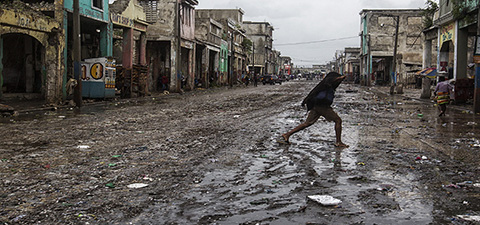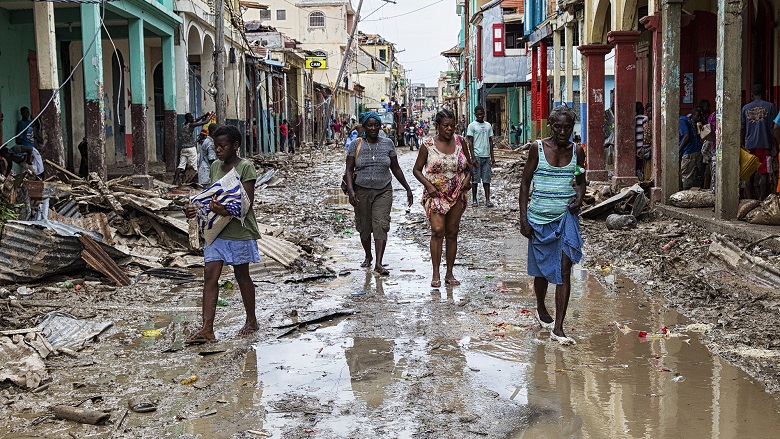Synopsis
The Haitian population is one of the most exposed in the world to natural disasters, including hurricanes, floods, and earthquakes. The number of disasters per kilometer tops the average for other Caribbean countries. The Germanwatch Global Climate Risk Index ranked Haiti third in the world in 1995–2014 for impacts from climatic events, and the country is among the ten zones in the world considered most vulnerable to climate change. In 2008, tropical storms and hurricanes caused losses estimated at 15 percent of GDP. The earthquake on January 12, 2010, killed 220,000 people, displaced 1.5 million people, and destroyed the equivalent of 120 percent of GDP. These disasters tend to disproportionately affect the poorest and most marginal populations, those settling in the flood zones and coastal areas particularly affected by tropical storms. Almost 50 percent of damage and losses to the productive sectors have been concentrated in the agricultural sector. Based on available historic data, weather-related disasters are estimated to have caused damage and losses in Haiti amounting to about two percent of GDP on average per year from 1975 to 2012.
Challenge
Hurricane Matthew struck Haiti on October 4, 2016, as a Category 4 hurricane. The combined effects of wind, coastal flooding and rain caused heavy flooding, landslides, and the destruction of a great deal of infrastructure, agricultural crops and natural ecosystems. In all, 546 people were killed, more than 175,500 people sought refuge in shelters, and about 1.4 million people required immediate humanitarian assistance. An assessment of the damage and losses had to be carried out very quickly to unlock financial resources from the World Bank Group (WBG) and the International Monetary Fund to provide the assistance needed by those affected by the disaster.
Approach
The WBG, in partnership with the Inter-American Development Bank, closely supported the client through data gathering from field visits, phone surveys, and satellites and drones, as well as simulations through modelling. A full report assessing the damage and losses was delivered less than two weeks after the request, a task that usually takes at least three months. This rapid assessment covered all affected sectors and was the first multi-sectoral evaluation of the socioeconomic impacts of the hurricane as well as of its macroeconomic effects and impacts on individual and household income.
Results
Matthew was a Category 4 hurricane, an event predicted to occur only once every 56 years. It inflicted damage and losses in Haiti estimated at the equivalent of 22 percent of GDP. Specific impacts of the hurricane included the following:
- The disaster affected over 2 million people, about 20 percent of Haiti’s population, primarily in the poorest regions of the county.
- The hurricane resulted in flooding, landslides, and extensive destruction of infrastructure and livelihoods.
- The agriculture and housing/urban sectors were the hardest hit, with up to 90 percent of crops and livestock lost in some areas.
- Thousands of structures were damaged, and key roads and bridges were washed away.
- It’s estimated that over 450,000 children were out of school.
- The vaccine cold chain was destroyed.
- A sharp increase in suspected cholera cases was recorded in affected departments.
Assessing in record time the damage and losses, as well as identifying the most affected sectors and the potential human costs, led to rapid reallocation of about US$50 million from the Bank’s ongoing portfolio. The enabled responses included:
- Rehabilitation of roads and bridges, including the major bridge to the country’s south.
- Schools were repaired and refurnished, semi-permanent school shelters built, school children fed, and water treatment kits and school kits provided.
- Rapid response to cholera was strengthened.
- Emergency sanitation and chlorination water systems were implemented.
- Irrigations systems were rehabilitated, inputs for the next agricultural season were provided and seeds given to 2,500 farmers.
- Some entrepreneurs received cash transfers to cover damages and losses in the coffee, cocoa, and honey value chains.
- Portable solar lamps and solar household systems were made available, some distribution grids were rehabilitated, hurricane preparedness was strengthened and energy infrastructure vulnerability was reduced.
These rapid interventions not only helped to minimize losses in the winter harvest and prevent widespread famine, they also helped contain the cholera outbreak and limit migration and violence.
Bank Group Contribution
The World Bank, through the International Development Association (IDA), reallocated US$50 million from ongoing projects to the affected sectors. In addition, US$100 million under the IDA Crisis Response Window were mobilized for four additional financings to relaunch heavily damaged agriculture, restore connectivity through transport infrastructure and provide a robust cholera response.
Partners
Bank support focused on sectors with limited technical capacity, and particularly those sectors with counterparts in the government. The support promoted local ownership of the assessment by each of the line ministries while ensuring implementation of a standardized methodology. The rapid assessment benefited from joint support from the Inter-American Development Bank teams, FAO, UNICEF, and UNEP. In addition, the IMF mobilized US$ 41 million under their Rapid Credit Facility to help with urgent balance of payments needs in the aftermath of Matthew.
Beneficiaries
The rapid assessment allowed the identification of populations in need of urgent assistance, including over 30,000 children in affected schools. The assessment also provided information for effective targeting of rehabilitation efforts: about 45 school roofs and school grounds were rehabilitated, 60 semi-permanent shelters were built, and 4,000 pieces of school furniture (benches, desks, blackboards, etc.) were distributed, enabling schools to reopen and to increase their capacity in the short and medium term. In addition, 16,000 student kits (bag, books, notebooks, pens), 900 teacher kits (including dictionaries, compasses, rulers, maps), and 151 school kits (including blackboards and chalk) were distributed. Further efforts included providing 22,000 students in 90 schools in affected regions (Grand’Anse, Sud, and Nippes) with a daily snack and hot meal, as well as water-treatment and sanitation kits, soap, de-worming medication, vitamin A and cholera-prevention hygiene training.
Subsequent interventions targeted 1.5 million beneficiaries in areas with limited health service delivery infrastructure. Isolated populations in the southern peninsula benefited from the provision of health services through mobile clinics, and in Nippes, Grande-Anse and Sud,
300,000 children benefited from the restoration of basic infrastructure for immunization and vaccine cold chains.
Cash transfers and in-kind support will also be provided to 325 micro, small and medium-sized entrepreneurs. The cash transfers and in-kind support will help the beneficiaries recover from losses and continue productive activities in their respective value chain, i.e., coffee (Grand'Anse and Southeast); vetiver (South); and honey (Nippes).
Moving Forward
This rapid damage and losses assessment fed into the more thorough Post-Disaster Needs Assessment (PDNA) undertaken under the leadership of the Haitian Ministry of Planning, with support from the World Bank Group, the European Union, the Inter-American Development Bank, UNDP and various UN agencies. The PDNA was finalized in early January 2017 and launched by the President of the Republic in early February 2017. More importantly, this rapid assessment was instrumental in drawing up the needed framework and quickly moving from emergency response to recovery. Finally, this rapid assessment served as an important input to the preparation of the Bank’s first financing to reach the Board post–Hurricane Matthew. An International Development Agency education grant of US$ 30 million to maintain access to quality education in the areas most affected by Hurricane Matthew, delivered to the Board approximately five weeks after the disaster, was approved in November 2016.

